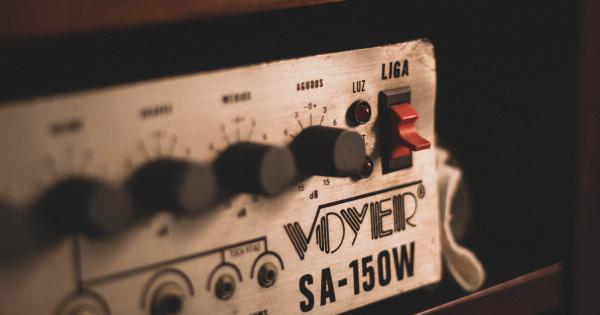Parkinson’s disease is a neurodegenerative disorder that affects millions of people worldwide. It is characterized by the progressive loss of dopamine-producing cells in the brain, leading to a wide range of motor and non-motor symptoms.
While there is currently no cure for Parkinson’s disease, researchers and healthcare professionals are continuously exploring various energy-boosting therapies as potential solutions to manage the condition’s symptoms and improve the quality of life for patients.
The Role of Energy in Parkinson’s Disease
Energy plays a crucial role in the overall functioning of our bodies, and it is no different when it comes to Parkinson’s disease.
The brain requires a significant amount of energy to perform its various functions, including the production and transmission of dopamine, a neurotransmitter that is essential for smooth movement.
In individuals with Parkinson’s disease, the decline in dopamine production affects the brain’s energy levels, leading to a range of symptoms, such as muscle stiffness, tremors, and fatigue.
Therefore, finding ways to boost energy in Parkinson’s patients may help alleviate these symptoms and improve their overall well-being.
Exercise as an Energy-Boosting Therapy
Regular exercise has been shown to have numerous benefits for individuals with Parkinson’s disease. It not only improves cardiovascular health but also helps boost energy levels and reduce fatigue.
Engaging in physical activities that increase the heart rate can stimulate dopamine production and improve overall brain function.
Studies have demonstrated that aerobic exercises, such as walking, swimming, and cycling, can have a positive impact on energy levels in Parkinson’s patients.
These activities promote the release of endorphins, which are natural mood enhancers and can help combat fatigue.
In addition to aerobic exercises, strength training and flexibility exercises can also contribute to increased energy levels.
Building muscle strength and improving flexibility can enhance overall body function and reduce the effort required for daily activities, thus conserving energy.
Dietary Adjustments for Energy Improvement
A well-balanced diet plays a vital role in maintaining overall health and energy levels. For individuals with Parkinson’s disease, certain dietary adjustments may help boost energy and manage symptoms more effectively.
Incorporating foods rich in antioxidants, such as fruits and vegetables, can help reduce oxidative stress and inflammation in the brain. This, in turn, may contribute to improved energy production and overall brain function.
Furthermore, including foods high in protein, such as lean meats, fish, and legumes, can provide the necessary building blocks for dopamine production.
Adequate intake of protein can help support the brain’s energy needs and alleviate some of the symptoms associated with dopamine depletion.
It is also important to stay hydrated, as dehydration can lead to fatigue and exacerbate symptoms. Drinking an adequate amount of water throughout the day can help maintain energy levels and support overall well-being.
Non-invasive Brain Stimulation Techniques
Non-invasive brain stimulation techniques, such as transcranial magnetic stimulation (TMS) and transcranial direct current stimulation (tDCS), have gained attention as potential energy-boosting therapies for Parkinson’s disease.
TMS uses magnetic fields to stimulate specific regions of the brain, promoting increased neural activity. This technique has shown promising results in improving motor symptoms and energy levels in Parkinson’s patients.
Similarly, tDCS involves applying a weak electric current to the scalp, which can modulate neuronal excitability and potentially enhance energy production in the brain.
While further research is needed to fully understand the effects and long-term benefits of these non-invasive brain stimulation techniques, initial studies indicate their potential as adjunct therapies to boost energy and improve symptoms in Parkinson’s disease.
Deep Brain Stimulation for Energy Enhancement
Deep brain stimulation (DBS) is a surgical procedure that involves implanting electrodes into specific areas of the brain to deliver electrical impulses.
Initially developed to manage motor symptoms in Parkinson’s disease, DBS has also shown potential in improving energy levels and overall quality of life for affected individuals.
DBS targets specific regions that regulate motor function and energy production, such as the subthalamic nucleus (STN). By stimulating these areas, DBS can modulate neuronal activity and restore normal energy balance in the brain.
While DBS is an invasive procedure and not suitable for all individuals with Parkinson’s disease, it has provided remarkable benefits in terms of energy enhancement and symptom management for those who are eligible and undergo the surgery.
Mindfulness and Stress Reduction
Chronic stress and anxiety can significantly impact energy levels and exacerbate the symptoms of Parkinson’s disease. Finding ways to cope with stress and promote relaxation can be beneficial for individuals with the condition.
Mindfulness techniques, such as meditation, deep breathing exercises, and yoga, have been shown to reduce stress and improve overall well-being.
These practices encourage focused attention and awareness, allowing individuals to better cope with the challenges of Parkinson’s disease and conserve their energy.
Moreover, participating in support groups and engaging in activities that promote social interaction can also contribute to stress reduction and overall energy improvement.
Connecting with others who share similar experiences can provide emotional support and a sense of community.
Music Therapy for Energy Boosting
Music has long been recognized for its therapeutic effects on the mind and body. In recent years, music therapy has gained prominence as a complementary approach to managing Parkinson’s disease symptoms and enhancing energy levels.
Listening to music or participating in music-based activities can activate various areas of the brain, stimulating movement and enhancing neuroplasticity.
This can lead to improved motor function and increased energy in individuals with Parkinson’s disease.
Additionally, music therapy has been shown to improve mood, reduce anxiety, and enhance overall well-being, providing a holistic approach to managing the challenges associated with Parkinson’s disease.
Functional Medicine and Energy Restoration
Functional medicine takes a comprehensive approach to healthcare, aiming to address the underlying causes of disease rather than only managing its symptoms.
In the context of Parkinson’s disease, functional medicine focuses on optimizing energy production and restoring balance in the body.
An important aspect of functional medicine for Parkinson’s is identifying and addressing potential nutritional deficiencies that may contribute to decreased energy levels.
This may involve targeted supplementation and personalized dietary interventions to support optimal brain and body function.
Furthermore, functional medicine practitioners may explore other factors that can affect energy levels, such as gut health, hormonal imbalances, and environmental toxins.
By addressing these underlying issues, functional medicine can play a significant role in energizing individuals with Parkinson’s disease and improving their overall quality of life.
Conclusion
Parkinson’s disease presents numerous challenges for individuals living with the condition.
However, through the exploration of energy-boosting therapies, researchers and healthcare professionals are finding potential solutions to manage symptoms and enhance the quality of life for patients. From exercise and dietary adjustments to non-invasive brain stimulation techniques and mindfulness practices, there are several avenues to explore in the search for energy enhancement in Parkinson’s disease.
By harnessing these therapies and continuously advancing our understanding of the complex interplay between energy and the disease, we can progress towards a future where individuals with Parkinson’s can lead fulfilling and vibrant lives.



























